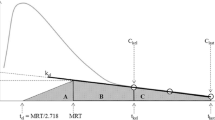Abstract
Background
Oral clearance (CL/F) is an important pharmacokinetic parameter and plays an important role in the selection of a safe and tolerable dose for first-in-human studies. Throughout the pharmaceutical industry, many drugs are administered via the oral route; however, there are only a handful of published scaling studies for the prediction of oral pharmacokinetic parameters.
Methods
We evaluated the predictive performances of four different allometric approaches–simple allometry (SA), the rule of exponents, the unbound CL/F approach, and the unbound fraction corrected intercept method (FCIM)–for the prediction of human CL/F and the oral area under the plasma concentration-time curve (AUC). Twenty-four compounds developed at Johnson and Johnson Pharmaceutical Research and Development, covering a wide range of physicochemical and pharmacokinetic properties, were selected. The CL/F was predicted using these approaches, and the oral AUC was then estimated using the predicted CL/F.
Results
The results of this study indicated that the most successful predictions of CL/F and the oral AUC were obtained using the unbound CL/F approach in combination with the maximum lifespan potential or the brain weight as correction factors based on the rule of exponents. We also observed that the unbound CL/F approach gave better predictions when the exponent of SA was between 0.5 and 1.2. However, the FCIM seemed to be the method of choice when the exponent of SA was <0.50 or >1.2.
Conclusions
Overall, we were able to predict CL/F and the oral AUC within 2-fold of the observed value for 79% and 83% of the compounds, respectively, by selecting the allometric approaches based on the exponents of SA.










Similar content being viewed by others
References
Mordenti J. Man versus beast: pharmacokinetic scaling in mammals. J Pharm Sci 1986; 75: 1028–40
Mahmood I, Balian JD. Interspecies scaling: predicting clearance of drugs in humans. Three different approaches. Xenobiotica 1996; 26: 887–95
Feng MR, Lou X, Brown RR, et al. Allometric pharmacokinetic scaling: towards the prediction of human oral pharmacokinetics. Pharm Res 2000; 17: 410–8
Tang H, Mayersohn M. A novel model for prediction of human drug clearance by allometric scaling. Drug Metab Dispos 2005; 33: 1297–303
Lave T, Dupin S, Schmitt C, et al. Integration of in vitro data into allometric scaling to predict hepatic metabolic clearance in man: application to 10 extensively metabolized drugs. J Pharm Sci 1997; 86: 584–90
Wajima T, Fukumura K, Yano Y, et al. Prediction of human pharmacokinetics from animal data and molecular structural parameters using multivariate regression analysis: oral clearance. J Pharm Sci 2003; 92: 2427–40
Mahmood I. Interspecies scaling: predicting oral clearance in humans. Am J Ther 2002; 9: 35–42
Tang H, Mayersohn M. A global examination of allometric scaling for predicting human drug clearance and the prediction of large vertical allometry. J Pharm Sci 2006; 95: 1783–99
Mahmood I. Prediction of human drug clearance from animal data: application of the rule of exponents and ‘fu corrected intercept method’ (FCIM). J Pharm Sci 2006; 95: 1810–21
Sacher G. Relation of lifespan to brain weight and body weight in mammals. In: Wolstenholme GEW, O’Connor M, editors. CIBA Foundation colloquia on ageing. 5th ed. London: Churchill, 1959: 115–33
Sheiner LB, Beal SL. Some suggestions for measuring predictive performance. J Pharmacokinet Biopharm 1981; 9: 503–12
Mahmood, I. Prediction of oral pharmacokinetic parameters. In: Mahmood I. Interspecies pharmacokinetic scaling. Rockville (MD): Pine House Publishers, 2005: 144–167
Lin JH. Species similarities and differences in pharmacokinetics. Drug Metab Dispos 1995; 23: 1008–21
Mahmood I. Interspecies scaling: role of protein binding in the prediction of clearance from animals to humans. J Clin Pharmacol 2000; 40: 1439–46
Boxenbaum H. Interspecies scaling, allometry, physiological time and the ground plan of pharmacokinetics. J Pharmacokinet Biopharm 1982; 10: 201–27
Boxenbaum H, Fertig JB. Scaling of antipyrine intrinsic clearance of unbound drug in 15 mammalian species. Eur J Drug Metab Pharmacokinet 1984; 9: 177–83
Bonati M, Latini R, Tognoni G, et al. Interspecies comparison of in vivo caffeine pharmacokinetics in man, monkey, rabbit, rat, and mouse. Drug Metab Rev 1984; 15: 1355–83
Klotz U, Antonin KH, Bieck PR. Pharmacokinetics and plasma binding of diazepam in man, dog, rabbit, guinea pig and rat. J Pharmacol Exp Ther 1976; 199: 67–73
Calder III WA. Size, function, and life history. Cambridge (MA): Harvard University Press, 1984
Sugita O, Sawada Y, Sugiyama Y, et al. Physiologically based pharmacokinetics of drug-drug interaction: a study of tolbutamide-sulfonamide interaction in rats. J Pharmacokinet Biopharm 1982; 10: 297–316
Jones HM, Parrott N, Jorga K, et al. A novel strategy for physiologically based predictions of human pharmacokinetics. Clin Pharmacokinet 2006; 45: 511–42
De Buck SS, Sinha VK, Fenu LA, et al. Prediction of human pharmacokinetics using physiologically based modelling: a retrospective analysis of 26 clinically tested drugs. Drug Metab Dispos 2007; 35: 1766–80
Acknowledgements
The authors would like to acknowledge the many Johnson and Johnson Research and Development ADME-TOX, Bioanalysis Department and Clinical Pharmacokinetics colleagues who generated data used in these analyses, and Drs Jim Dow, Eef Hoeben and Kelly Van Uytsel for their support and critical input. The authors have no conflict of interest relevant to the content of the study.
Author information
Authors and Affiliations
Corresponding author
Rights and permissions
About this article
Cite this article
Sinha, V.K., De Buck, S.S., Fenu, L.A. et al. Predicting Oral Clearance in Humans. Clin Pharmacokinet 47, 35–45 (2008). https://doi.org/10.2165/00003088-200847010-00004
Published:
Issue Date:
DOI: https://doi.org/10.2165/00003088-200847010-00004




